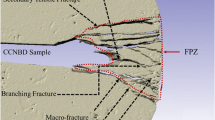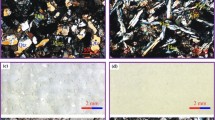Abstract
This report discusses the present state of knowledge with respect to the nature of the fundamental processes involved in rock breakage, both static and dynamic. Particular attention is paid to assessing the applicability to observed breakage phenomena of the several prevalent theories or criteria of rock failure. It is concluded that at best our understanding of rock breakage is inadequate and uncertain, with breakage under dynamic loads being somewhat better understood than under static loads.
Résumé
Cet exposé fait etat des connaissances actuelles sur les principales méthodes, tant du point de vue statique que dynamique, de rupture des toches. L' auteur compare les observations experimentales aux théories générales avancées ou aux critères connus de rupture des roches. Il conclue que notre connaissance dans ce domaine est incertaine et insufficiante, les effets dynamique de la rupture étant un peu mieux compris que les effets statiques.
Zusammenfassung
Der Vortrag behandelt unser heutiges Wissen von den fundamentalen statischen und dynamischen Prozessen, die beim Aufbrechen von Felsen vorkommen. Besonders Gewicht ist gelegt auf die Anwendbarkeit einiger vorherschender Theorien von Felspaltungen auf die beobachieten Aufbrecherscheinungen. Der Author kommt zu dern Schluss, dass unser Verständniss von Aufbrechen von Felsgestein unzureichend und lückenhaft ist; Hierbei kann das Brechen unter dynamischen Belastungen etwas besser verstanden werden als das unter statischen Belastungen.
Similar content being viewed by others
References
G. Galileo Two New Sciences (originally publ. in 1665), translated by. H.Crew and A deSalvio, Dover, New York 300p (1914).
American Society for Testing Materials ASTM Standards, pt. 2, 1102–1104 (1942).
I. Obert; S.L. Windes; W.I. Duvall “Standardized Tests for Determining the Physical Properties of Mine Rock,” U.S. Bur. Mines Rept. Inv. 389, 1–67 (1946).
C. Fairhurst “Laboratory Measurementof Some Physical Properties of Rock,” Penn. State Univ. Mineral Expt. Sta. Bul.. 76, 105–118 (1961).
M.M. Protodyakonov Mining Research, ed. G.B.Clark, Pergamon, New York, 859p (1962).
G. Hondros Austr. J. Appl. Sci., 10 (1959).
S.L. Windes “Physical Properties of Mine Rock,” pt. 1, U.S. Bur. Mines Rept. Inv. 4459 (1949).
S.L. Windes “Physical Properties of Mine Rock,” pt. 2, U.S. Bur. Mines Rept. Inv. 4727 (1950).
E.E. Blair “Physical Properties of Mine Rock,” pt. 3, U.S. Bur. Mines Rept. Inv. 5130 (1955).
E.E. Blair “Physical Properties of Mine Rock,” pt. 4, U.S. Bur. Mines Rept. Inv. 5244 (1956).
W.R. Judd; C. Huber ibid ref. 5.
R.G. Wuerker “Annotated Tables of Strength and Elastic Properties of Rocks,” Trans. 1956 AIME, Petroleum Branch (1956).
B.B. Clark; R.D. Caudle “Geologic Structure Stability and Deep Protection Construction,” Tech. Doc. Rept. AFSWC-TDR-61-93 (1961).
A.A. Griffith Phil. Trans. Roy. Soc. London, A221, 163–197 (1921).
A.A. Griffith Trans. First Intl. Cong. Appl. Mech., Delft, 55–63 (1924).
E. Orowan “Fracture and Strength of Solids,” Rept. Prog. Phys. 12, 185–232 (1949).
A. Nadai Theory of Flow and Fracture of Solids, McGraw-Hill, New York, 572p (1950).
D. P. Clausing “Comparison of Griffith's Theory and Mohr's Failure Criterion,” Colorado School Mines Quart., 54, 285–296 (1959).
A. Lisowski “Failure of Rock Cubic Specimens in the Light of the Theory of Elasticity,” Acad. Polonaise Sci. Bull., Serv. Sci. Tech. 7, 341–351 (1959).
J. C. Jaeger Elasticity, Fracture, and Flow, 2nd ed., John Wiley Sons, New York, 208 (1962).
W. F. Brace “Brittle Fracture of Rocks,”Proc. Symp.Stress in Earth's Crust, Santa Monica, 1963 - in press.
G. R.Irwin Fracture: Handbuch der physik, no. 6, ed. S.Flügge, Springer, Berlin, 551–591 (1958).
W. F. Brace, E. G. Bombola J. Geophys. Res., 68, pp3709–3713 (1963). kis
E. Hoek; Z.T. BieniawskiIntl. J. Frac. Mech.,1, 137–155 (1965).
T. von KarmanZa. Ver. dent. Ing., 55, 1749–1757 (1911).
U. S. Btu. Reclamation“Physical Properties of Some Typical Foundation Rocks,” Concrete Lab. Rept. SP-39 (1963).
J. Handin; R. V. Hager, Jr. “Experimental Deformation of Sedimentary Rocks Under Confining Pressure — Tests at Room Temperature on Dry Samples,” Am. Assoc. Petroleum Geologists Bull. 41, 1–50 (1957).
N. J. Price Mechanical Properties of Non-Metallic Brittle Materials, ed. W. H. Walton, Interscience, New York, 492 (1958).
G. D. Boozer; K. H. Hiller; S. Serdengecti Rock Mechanics, ed. C. Fairhurst, Pergamon, New York, 726p (1963).
G. Balmer ASTM Proc., 1260–1271 (1952).
I. Evans; C: D. Pomeroy ibid ref.28.
S. A. F. Murrell ibid ref. 28.
D. P. Krynine Soil Mechanics, McGraw-Hill, New York, 5llp (1947).
M. K. Hubbert; W. W. Rubey “Role of Fluid Pressure in Mechanics of Overthrust Faulting,” Geol. Soc. Am. Bull. 70, 115–206 (1969).
S. A. F. Murrellibid ref. 29.
A. Foppl“Mitteilungen aus dem Mechan,” Techn. Lab. der Techn. Hochsch., Munchen (1900).
P. W. Bridgman Studies in Large Platic Flow and Fracture, McGraw-Hill, New York (1952).
H. Ode “Faulting as a Velocity Discontinuity in Plastic Deformation,” Geol.Soc.Am. Memoir 79, 293–321 (1960).
W. F. Brace J. Geophys. Res., 65, 3477–3480 (1960).
W. F. Brace“Dependence of Fracture Strength of Rocks on Grain Size,” Penn. State Univ. Mineral Expt. Sta. Bull. 76, 99–103 (1961).
F.A. McClintock; J.Walsh “Friction on Griffith Cracks in Rocks Under Pressure,” Trans. Intl. Cong. Appl. Mech., Berkeley, 1962 — in press.
Drilling Research Inc. Collected reports (1949–1954).
I.Evans; S.A.F. Murrell ibid ref. 28
H.L. Hartman Trans.AIME (Mining), TP4785A, 214, 68–75 (1959).
S. Tandanand; H. L. Hartman ibid ref. 5.
I. Evansibid ref. 5.
H. Kolsky; A.C. Shearman Research, 2, 384 (1949),
H. SchardinGlastech. Ber., 23,1–10; 67–79; 325–336 (1950).
J.S. Rinehart; J.S. Pearson Behavior of Metals Under Impulsive Loads, Am.Soc.of Metals, Cleveland, 256p (1954), Dover 1964.
J. S. Rinehart “On Fractures Caused by Explosions and Impacts,” Colorado School Mines Quart., 55, 4, 155p (1960).
J. S. Rinehart Trans. Intl. Symp. on Stress Wave Propagation in Materials, ed. N.Davids, Interscience, New York (1960).
J. S. Rinehartibid ref. 5.
I.S.Rinehart “Transient Stress Wave Boundary Interactions,” Proc. Intl. Symp. on Stress Waves in Anelastic Solids, Brown University, 1963 — in press.
W.I. Duvall; T.C.Atchison “Rock Breakage by Explosives,” U.S. Bur. Mines Rept. Inv. 5356 (1957).
J. B. Johnson ibid ref. 29.
T.C. Atchison; W.I. Duvall “Rock Breakage in Quarry Blasting,” Penn. State Univ. Mineral Exp. Sta. Bull. 76, 163–169 (1961)
W.C. Maurer; J.S. Rinehart J.Appl.Phys., 31, 1247–1252 (1960).
B. H. Bergstrom ibid ref. 29.
S. Patterson ibid ref.28.
H. C. Grimshaw ibid ref. 28.
T. R. Seidenrath; J. Gramberg ibid ref. 28.
D. R. Reichmuth ibid ref. 29.
Author information
Authors and Affiliations
Rights and permissions
About this article
Cite this article
Rinehart, J.S. Fracture of rocks. Int J Fract 2, 534–551 (1966). https://doi.org/10.1007/BF00193692
Received:
Issue Date:
DOI: https://doi.org/10.1007/BF00193692




